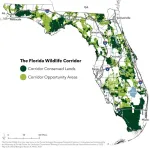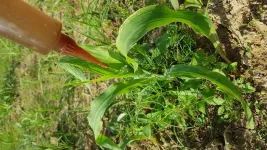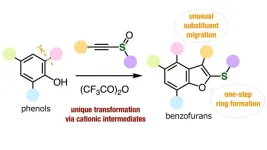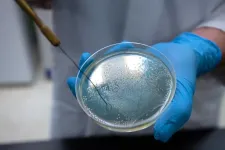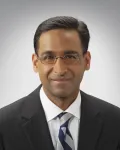(Press-News.org) Shipowners around the world are in a very difficult position, because they are having to order new ships now that will run on fuel and technologies that are not yet fully developed.
A new study suggests that ammonia could be a smart and energy-efficient fuel in the race to achieve net zero in shipping. Researchers at the Department of Industrial Economics and Technology Management (IØT) and the Department of Marine Technology (IMT) at the Norwegian University of Science and Technology (NTNU) and SINTEF Ocean are behind the study.
Help making choices in uncertain times
The researchers have developed a new model that can help shipowners and ship designers make good decisions in a time of great uncertainty. The study was recently published in Maritime Transport Research.
Postdoctoral fellow Benjamin Lagemann at the Department of Marine Technology describes the challenges the industry is facing:
“They need to choose a machinery system and make plans for the future. At the same time, there is considerable uncertainty related to fuel prices, carbon pricing, fuel bunkering availability and safety,” he says.
Anyone investing in new ships or upgrading their fleet must make decisions now, or have plans for how they intend to meet the climate requirements.
Must be equipped for unknown requirements
The ships that are now being ordered will likely be part of the international fleet in 2050.
They need to be equipped such that the enormous machinery can be converted to run on new types of fuel in the future. In shipping terminology, this is called retrofitting.
“A lot is still under development, but the decisions made today will affect the possibilities for retrofitting and fuel choices in the future. This means that the shipowners have to commit to a decision to a certain extent, and thereby run the risk of not meeting future standards and expectations related to the environment,” says Lagemann.
Supramax ships as an example
The study is based on a fleet of Supramax ships. The model incorporates factors such as emission figures from production to end use using a variety of different fuels, prices and other assumptions.
The ambition of the International Maritime Organization (IMO) is for shipping to be climate neutral by 2050. In addition, the industry must achieve major emission cuts by 2030 and 2040.
The NTNU researchers’ model shows that IMO’s ambitions have a strong impact on shipowners and ship designers’ choice of propulsion systems.
“Anyone investing in new ships or upgrading their fleet must make decisions now, or have plans for how they intend to meet the climate requirements,” says Professor Kjetil Fagerholt from the Department of Industrial Economics and Technology Management.
Shipowners need to act quickly
A lot is at stake, and shipowners need to act quickly. A standard Supramax cargo ship costs approximately NOK 300 million to build, and specialized ships can cost a lot more. The service life of these vessels is typically 20–30 years.
There is still a lot we don’t know about the new low and zero-emission fuels, and how they will affect technology, machinery and propulsion systems. This year, a carbon quota system for shipping will be introduced in the EU, but no one knows what the carbon prices will be in the future.
Decisions must be sustainable
The researchers have fed all the variables into the models, and developed a probability distribution for how conditions might develop in the future.
“We create many different scenarios of what might happen, but don’t draw any final conclusions on any of the outcomes,” says Fagerholt.
Benjamin Lagemann says the model highlights many of the issues related to the choice of fuels, but not all of them. It requires few input parameters, and is therefore relatively easy to reuse. The intention is to give an indication of which solutions will work best over time.
Ammonia for the most ambitious
More than 80 per cent of the goods in global trade are transported refrigerated. The Supramax ships on which NTNU researchers’ models are based are around 200 metres long, transport dry loads and weigh between 58,000 and 65,000 deadweight tonnes. There are currently almost 3000 ships of this type in operation, and they account for almost 10 per cent of global transport operations measured in tonne-miles.
It is not yet known what the requirements for emission cuts are going to be, so the researchers have studied two scenarios. One of them assumes a 90 per cent cut in emissions by 2045. The conclusion is that the fleet should be designed for ammonia-based propulsion systems. If the ambitions are lowered to a 50 per cent cut in emissions, the model recommends liquefied natural gas, i.e. methane-based propulsion systems.
Many factors point towards ammonia
In recent years, many reports have indicated that ammonia could lead the fleet into an emission-free future. The acrid smell of this chemical that is used in detergents and agricultural fertilisers is something we all recognise. When properly produced and used, ammonia can be an energy-efficient fuel to replace today’s polluting fossil fuels. Ammonia does not emit any CO2, sulphur oxides or particles.
Providing advice for operating entire fleets
The researchers’ work builds on previous research from postdoctoral fellow Benjamin Lagemann, showing how one single ship could be retrofitted over time to meet increasingly strict emissions requirements. They have now expanded the model to what they call a fleet perspective, and created two versions.
Simply explained, one version can suggest what shipping companies with many ships of different ages should do, and when it is smartest to do so. The other version will provide decision support to shipowners planning to build an entire fleet of new ships. One example is companies that are currently investing in building a fleet of completely new ammonia-powered ships.
Interest from home and abroad
When shipping companies invest, they want two things at once: the investment should yield the highest possible return while minimising the danger of unwanted risk. A company with 12 ships can spread the risk over time by choosing three different technologies for fuel and engine types. All of them can be retrofitted, but not all of them need to be retrofitted at the same time.
When the researchers were asked if they know whether their models will actually be used by those who need them, Lagemann replies:
“No, we don’t know. But several industry actors, designers and shipping companies, both in Norway and abroad, have shown interest.”
Reference:
Olav Loennechen, Kjetil Fagerholt, Benjamin Lagemann, Magnus Stålhane: Maritime fleet composition under future greenhouse gas emission restrictions and uncertain fuel prices https://doi.org/10.1016/j.martra.2024.100103
END
Researchers can help shipowners achieve ambitious climate targets
Ammonia could help bridge the gap between today's shipping fuels and tomorrow's zero-carbon shipping
2024-04-16
ELSE PRESS RELEASES FROM THIS DATE:
Florida Wildlife Corridor eases worst impacts of climate change
2024-04-16
From rising temperatures and altered precipitation patterns to intense weather events such as hurricanes, Florida is experiencing significant climate-related challenges in tandem with skyrocketing insurance rates. As the state’s population continues to surge by 1,000 new residents a day, it is projected to lose 3.5 million acres of land to development by 2070, threatening Florida’s future ability to maintain biodiversity and ecosystem services.
A first-of-its-kind study highlights how Florida can buffer itself against both climate change ...
Creating an island paradise in a fusion reactor
2024-04-16
In their ongoing quest to develop a range of methods for managing plasma so it can be used to generate electricity in a process known as fusion, researchers at the U.S. Department of Energy’s (DOE) Princeton Plasma Physics Laboratory (PPPL) have shown how two old methods can be combined to provide greater flexibility.
While the two methods – known as electron cyclotron current drive (ECCD) and applying resonant magnetic perturbations (RMP) – have long been studied, this is the first time researchers have simulated how they can be used together to ...
Field-margin wetlands alone can’t fix the Gulf of Mexico’s dead zone
2024-04-16
Each summer, a hypoxic dead zone forms in the Gulf of Mexico, making some marine habitats unlivable. The dead zone is caused by nutrients—primarily from agricultural fertilizers—flowing into the Gulf from the Mississippi River. Restoring wetlands at field margins has been proposed to intercept some of the runoff, as wetland plants and soils are capable of absorbing nutrients like a living sponge. But estimates of nutrient removal by restored wetlands have varied widely. Shan Zuidema and colleagues took a whole-system approach to modeling the potential for wetlands to ameliorate the flow of nitrate to the ...
Research has lost none of its innovative drive
2024-04-16
A high-profile study made headlines in 2023 stating that the scientific and innovation system is producing less and less completely new knowledge. Researchers at the University of Basel are now refuting this claim, at least for patents: It is based on a measurement error.
The discovery of mRNA in the 1960s was groundbreaking. Suddenly there were completely new findings that ushered in new developments. This kind of discovery is described as “disruptive”. In contrast, research findings are “consolidating” when they build upon existing knowledge. They are also important, as the example of the ...
A nematode gel to protect crops in Africa and Asia
2024-04-16
The fall armyworm is a destructive corn pest, which recently arrived in Africa and Asia from the Americas and began causing major yield losses and increased use of insecticides, which pose environmental and human health risks. Entomopathogenic nematodes are soil-dwelling roundworms that can parasitize and kill fall armyworms with no risks to people or the environment, but application can be tricky because the nematodes are susceptible to desiccation and UV radiation from sunlight. Patrick Fallet and colleagues report success using an innocuous biodegradable ...
Breakthrough in benzofuran synthesis: New method enables complex molecule creation
2024-04-16
In the field of organic chemistry, scientists are always looking out for new types of reactions to unlock synthesis routes for challenging compounds. Most of the progress that we have witnessed in pharmaceutics and agrochemicals over the past few decades can be traced back to the discovery of novel practical reaction pathways. Such pathways often involve the selective replacement of a functional group with another, the formation of aromatic rings, or the strategic cleaving of parts of a molecule. But what about the rearrangement of existing functional groups within a molecule?
Also known as ‘substituent ...
Exploring the interactions between baby marmosets and their caregivers
2024-04-16
The connection that infants form with their parents or caregivers is crucial for their cognitive, social, and emotional development. These attachments vary in quality, depending on how caregivers respond to the infant's needs. When caregivers are attentive, infants are likely to develop secure attachments. However, if caregivers neglect their needs, infants may develop insecurity, leading to challenges in emotional development and difficulty in forming healthy relationships later in life.
To understand how parenting influences attachment formation and child development, researchers led by Associate Professor Atsuko ...
MD Anderson and CureVac enter strategic collaboration to develop novel cancer vaccines
2024-04-16
HOUSTON and TÜBINGEN, Germany ― The University of Texas MD Anderson Cancer Center and CureVac N.V. today announced a co-development and licensing agreement to develop novel mRNA-based cancer vaccines.
The collaboration creates strong synergies between CureVac’s unique end-to-end capabilities for cancer antigen discovery, mRNA design, and manufacturing and MD Anderson’s expertise in cancer antigen discovery and validation, translational drug development, and clinical research. The collaboration will focus on the development of differentiated cancer vaccine ...
Deadly bacteria show thirst for human blood
2024-04-16
PULLMAN, Wash. – Some of the world's deadliest bacteria seek out and feed on human blood, a newly-discovered phenomenon researchers are calling “bacterial vampirism.”
A team led by Washington State University researchers have found the bacteria are attracted to the liquid part of blood, or serum, which contains nutrients the bacteria can use as food. One of the chemicals the bacteria seemed particularly drawn to was serine, an amino acid found in human blood that is also a common ingredient in protein drinks.
The research finding, published in the journal eLife, provides new insights into how bloodstream infections ...
New insights could unlock immunotherapy for rare, deadly eye cancer
2024-04-16
New research from the University of Pittsburgh explains why metastatic uveal melanoma is resistant to conventional immunotherapies and how adoptive therapy, which involves growing a patient’s T cells outside the body before reinfusing them, can successfully treat this rare and aggressive cancer.
In a paper published today in Nature Communications, the Pitt researchers also explain how they developed a new clinical tool that predicts which patients will respond to adoptive therapy. The work, supported by UPMC Enterprises, is helping improve personalized therapies and avoid futile treatments for metastatic uveal melanoma.
“The dogma was that uveal melanoma is ...
LAST 30 PRESS RELEASES:
Interaction of climate change and human activity and its impact on plant diversity in Qinghai-Tibet plateau
From addressing uncertainty to national strategy: an interpretation of Professor Lim Siong Guan’s views
Clinical trials on AI language model use in digestive healthcare
Scientists improve robotic visual–inertial trajectory localization accuracy using cross-modal interaction and selection techniques
Correlation between cancer cachexia and immune-related adverse events in HCC
Human adipose tissue: a new source for functional organoids
Metro lines double as freight highways during off-peak hours, Beijing study shows
Biomedical functions and applications of nanomaterials in tumor diagnosis and treatment: perspectives from ophthalmic oncology
3D imaging unveils how passivation improves perovskite solar cell performance
Enriching framework Al sites in 8-membered rings of Cu-SSZ-39 zeolite to enhance low-temperature ammonia selective catalytic reduction performance
AI-powered RNA drug development: a new frontier in therapeutics
Decoupling the HOR enhancement on PtRu: Dynamically matching interfacial water to reaction coordinates
Sulfur isn’t poisonous when it synergistically acts with phosphine in olefins hydroformylation
URI researchers uncover molecular mechanisms behind speciation in corals
Chitin based carbon aerogel offers a cleaner way to store thermal energy
Tracing hidden sources of nitrate pollution in rapidly changing rural urban landscapes
Viruses on plastic pollution may quietly accelerate the spread of antibiotic resistance
Three UH Rainbow Babies & Children’s faculty elected to prestigious American Pediatric Society
Tunnel resilience models unveiled to aid post-earthquake recovery
Satellite communication systems: the future of 5G/6G connectivity
Space computing power networks: a new frontier for satellite technologies
Experiments advance potential of protein that makes hydrogen sulfide as a therapeutic target for Alzheimer’s disease
Examining private equity’s role in fertility care
Current Molecular Pharmacology achieves a landmark: real-time CiteScore advances to 7.2
Skeletal muscle epigenetic clocks developed using postmortem tissue from an Asian population
Estimating unemployment rates with social media data
Climate policies can backfire by eroding “green” values, study finds
Too much screen time too soon? A*STAR study links infant screen exposure to brain changes and teen anxiety
Global psychiatry mourns Professor Dan Stein, visionary who transformed mental health science across Africa and beyond
KIST develops eco-friendly palladium recovery technology to safeguard resource security
[Press-News.org] Researchers can help shipowners achieve ambitious climate targetsAmmonia could help bridge the gap between today's shipping fuels and tomorrow's zero-carbon shipping



